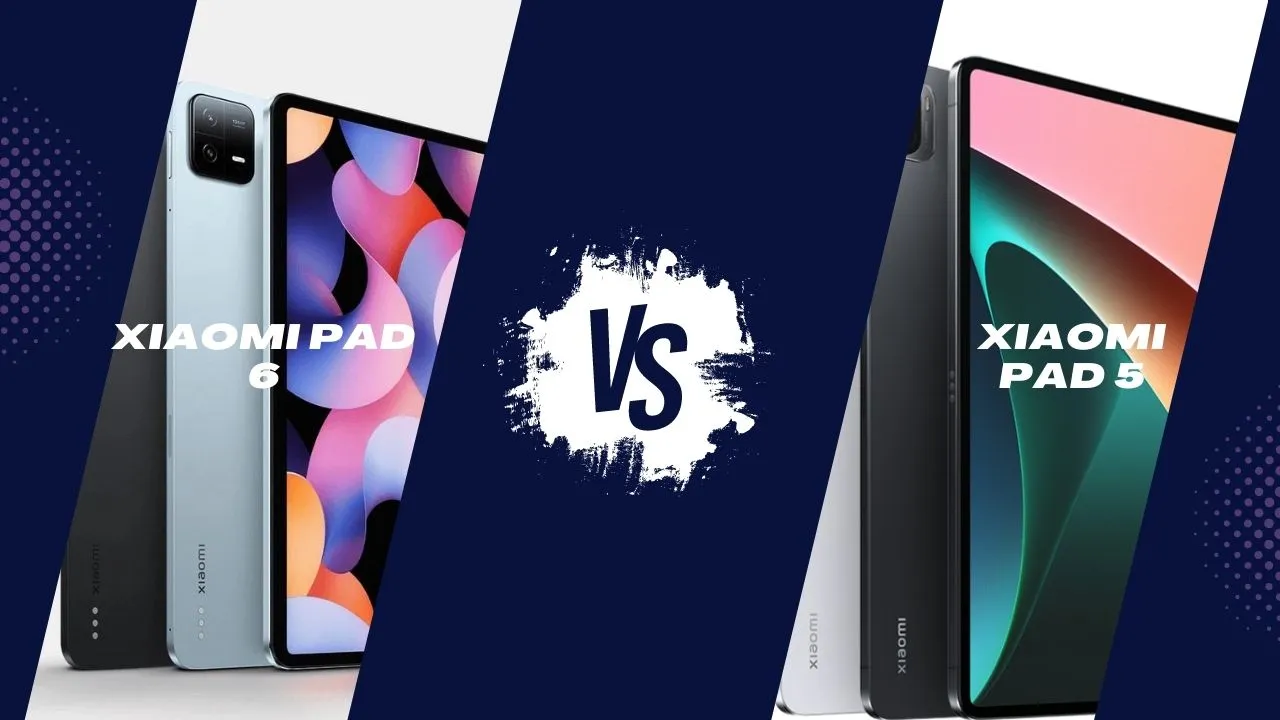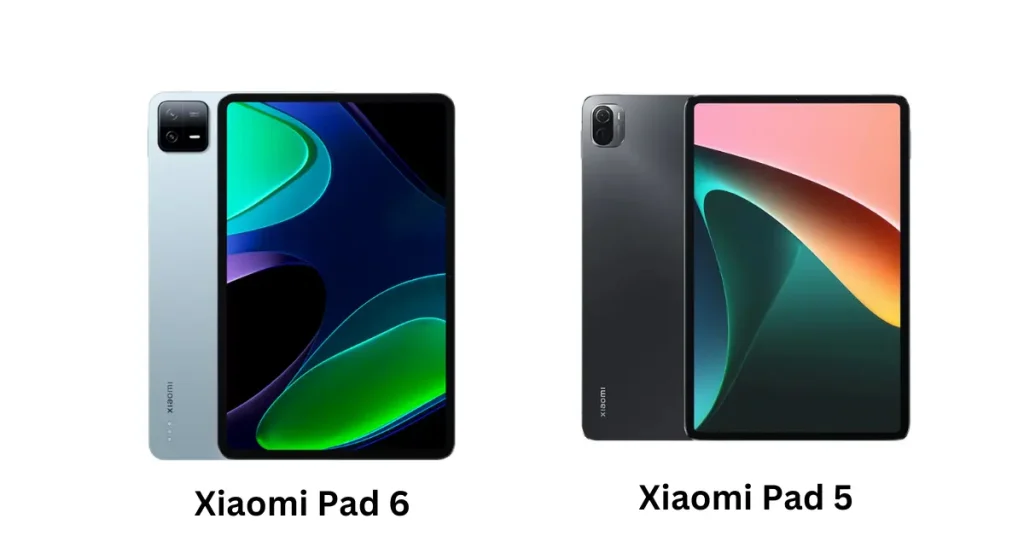Xiaomi Pad 6 vs. Xiaomi Pad 5: Which One is Right for You?

We often face a dilemma when a popular device receives an updated version. Should I choose the new version or the old one? With the global release of the Xiaomi Pad 6, users now have two compelling options to choose from Xiaomi Pad 6 & Xiaomi Pad 5. To alleviate this confusion, I will thoroughly analyze both tablets’ specifications, design, display, performance, battery life, camera quality, and other features. I hope that by the end of this review, you will clearly understand which devices suit your needs better.
Xiaomi Pad 6 vs. Xiaomi Pad 5: Specs Comparison
| Specs | Xiaomi Pad 6 | Xiaomi Pad 5 |
|---|---|---|
| Weight | 490g | 511g |
| Resolution | 2880 x 1800 | 1600 x 2560 |
| Refresh rate | 144Hz | 120Hz |
| PPI | 309 | 275 |
| Brightness | 550 nits | 500 nits |
| Processor | Snapdragon 870 | Snapdragon 870 |
| GPU | Adreno 650 | Adreno 640 |
| RAM | LPDDR5 6GB/8GB | LPDDR4X 6GB |
| Battery | 8840mAh | 8720mAh |
| Bluetooth | 5.2 | 5.0 |
| WiFi | WiFi 6, WiFi 5, WiFi 4, & 802.11a / b / g | 802.11a/b/g/n/ac |
| Price | Check Price | Check Price |
10 Differences Between Xiaomi Pad 6 & Xiaomi Pad 5

1.Design & Build
Starting with the design and build, both Xiaomi Pad 6 and Xiaomi Pad 5 exude elegance and sophistication. The Xiaomi Pad 6 boasts a sleek and slim profile, weighing only 490 grams, making it highly portable and comfortable to hold for extended periods. On the other hand, the Xiaomi Pad 5 weighs slightly more at 511 grams but still maintains a slim form factor of approximately seven millimeters in thickness.
Regarding material choices, the Xiaomi Pad 6 features a premium finish with a sturdy metal body that radiates a premium feel. Meanwhile, the Xiaomi Pad 5 employs plastic on the back but cleverly captures light at certain angles, reducing fingerprint visibility.
Both tablets come with a rear camera; the Xiaomi Pad 6 sports a 13-megapixel camera with a microphone, while the Xiaomi Pad 5 features a similar 13-megapixel camera with a dual-tone LED flash, adding to its versatility. However, the absence of a fingerprint scanner on both tablets may disappoint some users who value quick and secure unlocking.
Design & Build Winner: It’s a tie. Both tablets showcase appealing designs, and it comes down to personal preferences between the metal finish of the Xiaomi Pad 6 and the light-capturing plastic back of the Xiaomi Pad 5.
2.Display & Features
When it comes to displays, both tablets offer impressive visuals, but there are some key differences to consider. The Xiaomi Pad 6 sports an 11-inch IPS screen with a 144Hz refresh rate, providing smooth and fluid animations and interactions. It boasts a resolution of 2880 by 1800, resulting in a pixel density of 309 PPI and Gorilla Glass 3 protection for added durability. While it falls short of an OLED panel, the IPS LCD still delivers vibrant colors and excellent touch response. Like Xiaomi Pad 5, it also comes with HDR10 and Dolby Vision.
On the other hand, the Xiaomi Pad 5 has an equally commendable 11-inch 1600 by 2560 display featuring a 120Hz refresh rate, ensuring a responsive and seamless user experience. The pixel density of 275 PPI and a maximum brightness of over 500 nits on the Xiaomi Pad 5 provides easy readability even in direct sunlight. The touch response is equally impressive, making both tablets enjoyable for various tasks.
Display Winner: The Xiaomi Pad 6 takes the edge with its higher refresh rate and better maximum brightness, offering a superior viewing experience in different lighting conditions.
3.Performance & Multitasking
Under the hood, the Xiaomi Pad 6 is powered by the Snapdragon 870 chipset, an older but capable processor performing remarkably well. It comes with 8GB of RAM and 128GB of storage, though a cheaper variant with 6GB of RAM is available. Additionally, upgrading to 8GB of RAM and 256GB of storage is an option. The tablet operates on Android 13, MIUI 14, which provides useful features such as floating windows and split-screen functionality, enhancing multitasking capabilities. The absence of bloatware and ads makes for a clean and seamless user experience.
On the other hand, the Xiaomi Pad 5 relies on the Snapdragon 860 chipset, which delivers excellent performance for various tasks despite being a step down from the Snapdragon 870. It comes with 6GB of RAM, which may be less than the Xiaomi Pad 6’s higher variant but is sufficient for most everyday applications and multitasking needs. Like the Xiaomi Pad 6, the MIUI OS interface is well-optimized for tablets, ensuring smooth and snappy performance. The 120Hz refresh rate further enhances the tablet’s responsiveness.
Performance Winner: The Xiaomi Pad 6 slightly outperforms the Xiaomi Pad 5 due to its more powerful Snapdragon 870 chipset and higher RAM capacity.
Geekbench 6 Score of Xiaomi Pad 6
| Geekbench Score | Xiaomi Pad 6 |
|---|---|
| Single-Core Score | 1259 |
| Multi-Core Score | 3033 |
Geekbench 5 Score of Xiaomi Pad 5
| Geekbench Score | Xiaomi Pad 5 |
|---|---|
| Single-Core Score | 460 |
| Multi-Core Score | 1990 |
4.Battery Life & Charging
Battery life is a crucial aspect of any tablet, and both Xiaomi Pad 6 and Xiaomi Pad 5 excel in this regard. The Xiaomi Pad 6 houses an 8840 mah battery, which, combined with dynamic refresh rate adjustment, offers around 8-9 hours of usage. While intense gaming may reduce the battery life to about 4-5 hours, the overall performance is still commendable. The charging is also blazing fast in Xiaomi Pad 6. In my test, it took 1 hr 45 mins to charge fully.
The Xiaomi Pad 5 is also impressive with its remarkable battery life, providing approximately 10 to 14 hours of usage. Charging is relatively fast, especially with a more powerful 33W charger.
Battery Life Winner: The Xiaomi Pad 5 is the clear winner in this category, offering a substantially longer battery life, making it more suitable for extended use without frequent recharging.
5.Camera Quality
When it comes to camera performance, both tablets manage to capture good-quality images and videos for a tablet. The Xiaomi Pad 6 comes with an 8-megapixel front camera and a 13-megapixel rear camera, while the Xiaomi Pad 5 features similar specs. However, both tablets have the added advantage of a dual-tone LED flash, which can help in low-light situations.
Camera Quality Winner: It’s a tie. Both tablets offer decent camera performance for a tablet, and the differences are not significant enough to declare a clear winner.
6.Audio & Speakers
Audio quality is crucial for an immersive multimedia experience, and both tablets deliver excellent sound. The Xiaomi Pad 6 comes with Dolby Atmos speakers, offering good volume levels and decent bass for an enjoyable audio experience. The Xiaomi Pad 5 also features Dolby Atmos-tuned quad speakers, providing similar audio quality.
Audio & Speakers Winner: It’s a tie. Both tablets deliver impressive audio performance, ensuring an enjoyable media consumption experience.
7.Smart Pen & Keyboard Support
For users who prefer to take notes or create digital art on their tablets, the inclusion of a stylus is essential. The Xiaomi Pad 6 offers the second-generation Xiaomi Smart Pen, featuring 4096 pressure sensitivity levels, magnetic charging, and low latency for a smooth and accurate writing or drawing experience.
Similarly, the Xiaomi Pad 5 supports Xiaomi Smart Pen first generation, which also features 4096 pressure sensitivity levels and magnetic wireless charging. Both styluses perform well for most tasks, providing users with versatile creative tools. Unfortunately, the first-generation Xiaomi Smart Pen doesn’t work on the Xiaomi Pad 6.
Additionally, both tablets support keyboard accessories. The Xiaomi Pad 6 has Pogo Pin connectors on the back for easy attachment of a type cover-style keyboard. The Xiaomi Pad 5 also offers support for an optional keyboard that attaches magnetically, providing a decent typing experience for an 11-inch tablet.
Smart Pen and Keyboard Support Winner: It’s a tie. Both tablets provide excellent stylus options and keyboard support, catering to users with diverse productivity needs.
8.Gaming Performance
Gaming performance is a critical factor for many tablet users, and both the Xiaomi Pad 6 and Xiaomi Pad 5 deliver smooth gaming experiences. The Xiaomi Pad 6’s Snapdragon 870 chipset ensures most games run flawlessly at 60 frames per second, providing a satisfying gaming session. However, graphically intense games like Genshin Impact may require some compromise in visual settings to maintain a smooth gameplay.
Similarly, the Xiaomi Pad 5’s Snapdragon 860 handles most games well, and the 120Hz refresh rate enhances the overall gaming experience. Like the Xiaomi Pad 6, graphically demanding games may require adjustments to achieve optimal performance.
Gaming Performance Winner: The Xiaomi Pad 6 has a slight edge with its Snapdragon 870 chipset, offering marginally better performance for demanding games.
Xiaomi Pad 6 Gaming Performance Benchmark
| Game | Graphics Setting | FPS | Experience |
|---|---|---|---|
| PUBG Mobile | Extreme, Smooth | 50-60 | Smooth. Battery dropped to 85% after 40 mins gameplay. |
| Genshin Impact | Medium | 30 | Smooth Optimal Performance |
9.Additional Features & Connectivity
In terms of additional features, both tablets have some similar strengths and limitations. Both tablets boast fast read and write speeds with their UFS 3.1 storage, making app launches and data transfers swift and smooth. However, both lack a 3.5mm headphone jack, which may inconvenience users who prefer wired headphones.
The Xiaomi Pad 6 offers impressive WiFi connectivity with support for WiFi 6, WiFi 5, WiFi 4, and 802.11a/b/g, ensuring fast and reliable internet speeds. It also features Bluetooth 5.2 and supports video out capability via HDMI to Type-C cable.
On the other hand, the Xiaomi Pad 5 lacks support for Bluetooth 5.2 and WiFi 6. Additionally, unlike the Xiaomi Pad 6, it doesn’t support video-out capability.
Additional Features & Connectivity Winner: The Xiaomi Pad 6 has a slight advantage due to its WiFi 6 & Bluetooth 5.2 support.
10.Price & Value
Finally, let’s consider the pricing and overall value of both tablets. The Xiaomi Pad 6 is competitively priced (check Price), offering a balanced performance and impressive features. While it may lack a few convenience features, its affordability compensates for those drawbacks.
The Xiaomi Pad 5, on the other hand, also comes with a mid-range price tag (Check Price) and offers several compelling features, such as impressive battery life and a smooth 120Hz display. However, the absence of certain features, such as video out capability, WiFi 6, and Bluetooth 5.2 support, may deter some users.
Price & Value Winner: It’s a tie. Both tablets offer good value for their respective price points, and the final decision may depend on the user’s specific needs and preferences.
Conclusion
There is little differentiation between these two tablets, except for the processor and display. The price difference is also not that significant. Unless you specifically need raw processing power, you may opt for the cheaper Xiaomi Pad 5. On the other hand, if you desire a slightly enhanced display and the Snapdragon 870, then the Xiaomi Pad 6 would be a better choice.
Recommended Readings!
Amazon Fire Max 11 vs Fire HD 10 Plus: Which is Better?
